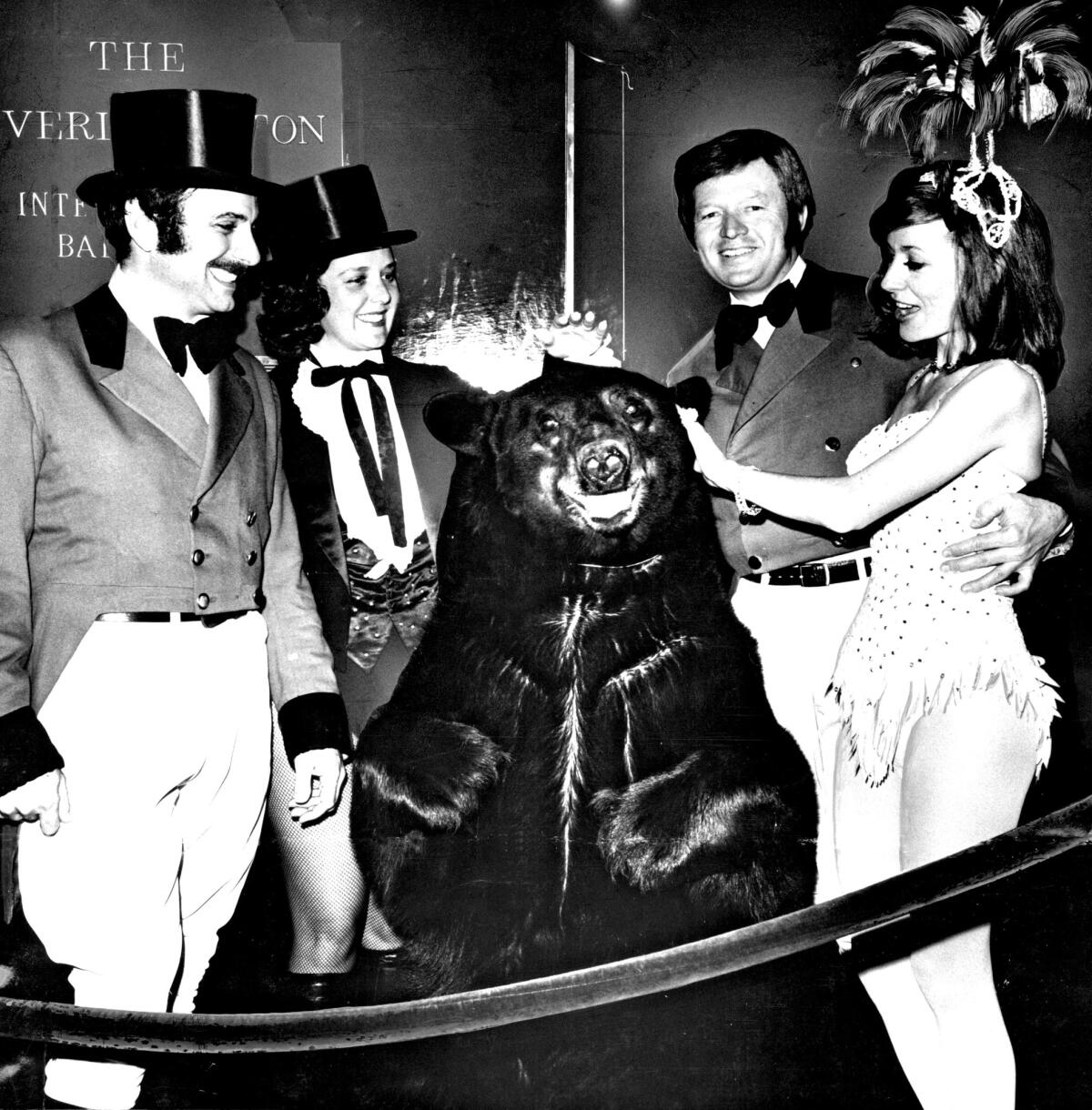Square dancing to heal the heart

At the Cowtown hall in Riverside, square dance callers turn some members of the Cowtown Singles club into partners for life.
- Share via
Dan Lawyer was on the dance floor with a woman who wasn't his wife.
Betty Lawyer would usually lend her husband out for at least one dance a night. The women outnumber the men by so much at Cowtown Square Dance Center, she had to. But tonight, she was sidelined by a knee injury and had to be satisfied with watching the other members of the Cowtown Singles dancing club weave and circle and shuffle across the hardwood floor, reclaimed from an old wooden boxcar.
Many had danced for so long, they could instantaneously process the caller's commands. Part conductor, part crooner, part comedian — the caller rattled off a litany of steps, blended with the lyrics of a Kenny Chesney song: Crossfire. Slide thru. Ferris wheel. Diamond circulate. Wheel and deal.
These days at Cowtown the dancers are older, and nights don't go as late as they once did. But when members gather for a dance, a lifetime's struggles vanish amid the rush of endorphins and rhythm of music.
He walked across the floor...and I said, 'He's my next victim!'”— Eva Arthurs, square dancer
Dancers tell you they come to this old hall on the outskirts of Riverside for the exercise. One dancer wore a pedometer as an experiment and found that, in a single night, she got in about three miles. It also keeps the mind sharp: Many claim square dancing fends off Alzheimer's.
They come for more than that, though.
They share a meal and maybe a little gossip. For so many who have lost spouses or divorced, Cowtown offers community. And plenty of them come across something they say they weren't looking for: love, and marriage.

Linda Selby, 62, had become a recluse after her husband died. For four years, she left the house only for work. Her next-door neighbors dragged her to square-dancing class. Now, on this night, she was sharing a square with her husband, Jim.
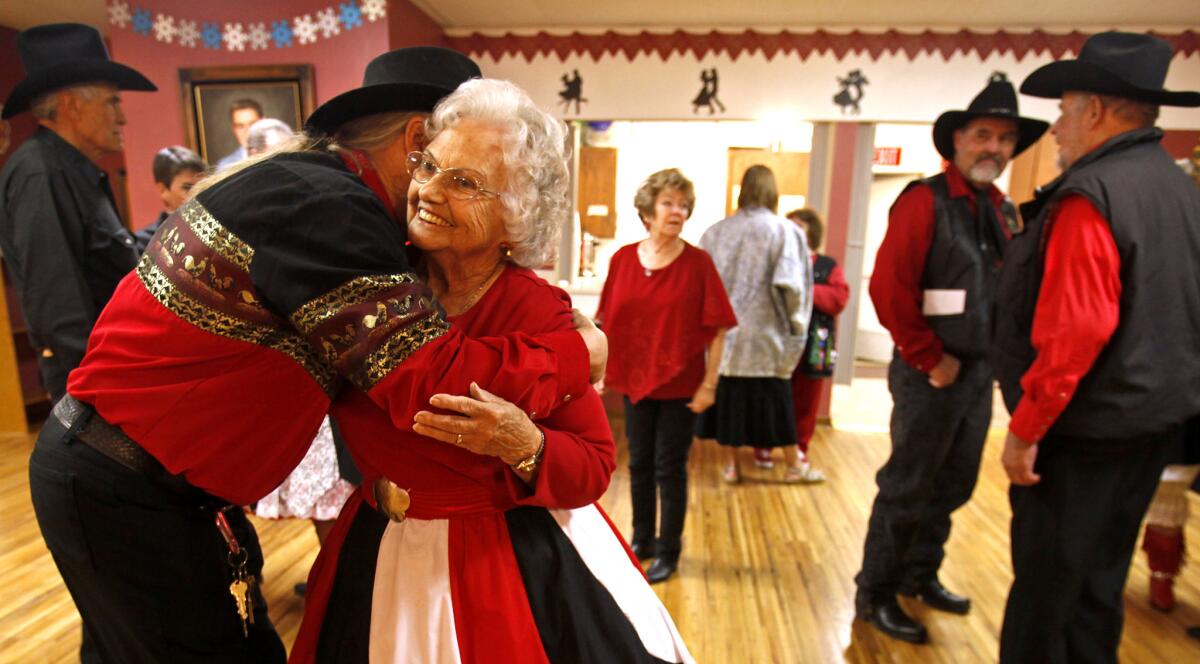
Reid Fahring, left, 63, of Fontana, hugs Lena Henderson, 85, of Riverside, after the last dance of the night at Cowtown. More photos
Janet Vinokur was bitter after a divorce. She swore off marriage. She would say half-jokingly that she wanted to get a tattoo on her wrist: I'm just here to dance. Then, she got on Phil Vinokur's dance card.
As the others danced, Betty Lawyer told her story: She was retired and a widow, and had moved to Riverside from Orange County. She used to square dance when she was younger, and in 2003, she picked it up again. She wanted to get out — find friends, maybe companionship. She didn't know where else to go.
"A bar?" said Lawyer, 76. "I don't think so!"
She met Dan in a square-dancing class. A year later, they were married.
"Here," she said, "you get a chance to get acquainted, week after week, until you get to know somebody."

The crimson dance hall set back on a hill was the idea of a caller named John Davis. Four decades ago, he envisioned a place owned by square dancers, where the needs of local dancing clubs came first.
A group of dancers found it in a seedy old honky-tonk in the boonies.
The owner had other plans for the property, but he was a square dancer himself and cut them a deal.
It took a lot of work to get the hall in shape. The only thing that stayed, it seemed, was the name: Cowtown. The enormous old bar was torn out. The hall's best asset — that wooden floor, half a foot thick — was installed. (Dancers gush about the floor: They say they can make it through a half-dozen tips, or dances, without an ache, and it doesn't scuff their dancing shoes like tile.)
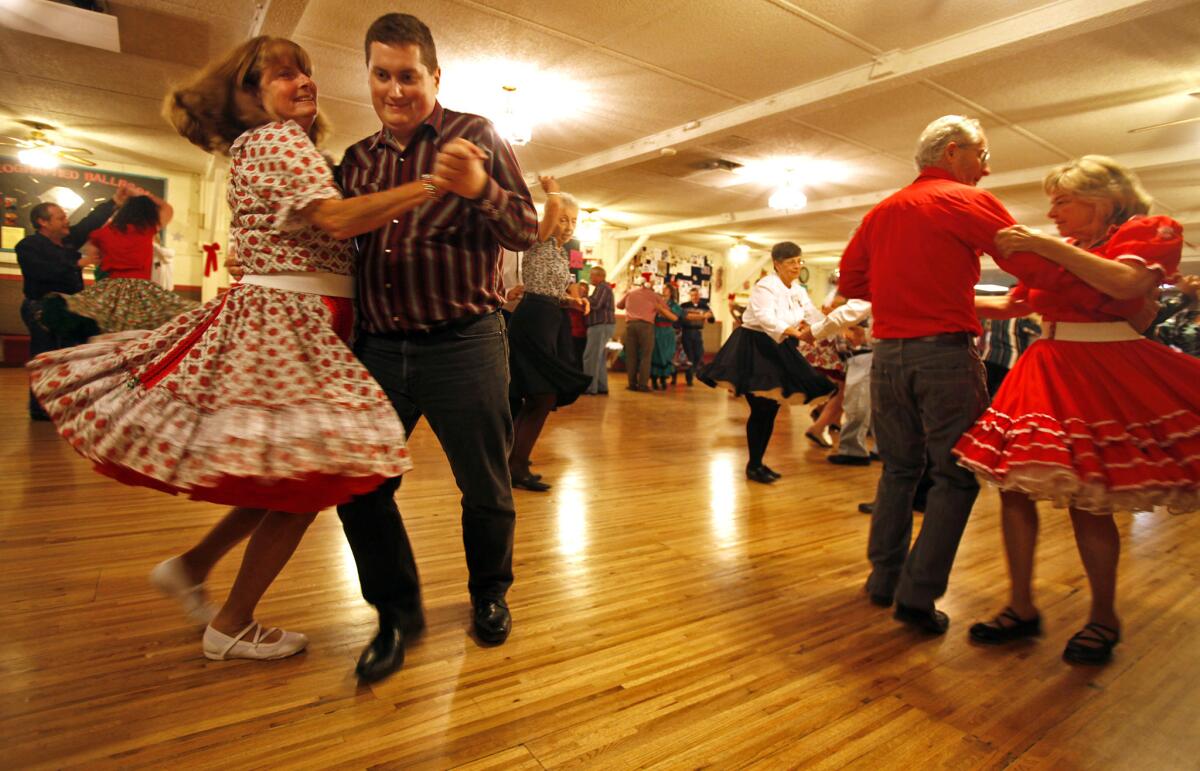
Nancy Saxon, 62, left, and Tyler Frederick, 26, twirl around the dance floor at the square-dance hall. More photos
"Oh, golly!" said Roy Henderson, 88, one in the cluster of shareholders who own the hall. "A lot of people told us it couldn't be done, but here it is!"
To make the mortgage payments, dancers had bake sales and horse shows. Some of the shareholders even took out second mortgages. When the hall was paid off — years early — they huddled around a bonfire and tossed the mortgage papers into the embers in jubilation.

Jim Selby can seem a little nervous. He admits he has to be careful, because the blues have a tendency to sneak up on him. But on this Friday night, dressed in a pink button-down and a bolo tie with an ornate buckle, he can't help but grin.
He was recalling the dance one night up the highway in Beaumont. He had pushed himself to go back to dancing after his wife died of cancer two years earlier. (He had met her at Cowtown years ago.)
That night, he spotted Linda with her friends and asked her to dance. The song was "Could I Have This Dance" by Anne Murray, a sappy ballad about finding love in a first dance.
"We just clicked together," Linda recalled.
It was such a happy place to come when there was so much sadness at home.”— Betty Lawyer
By then, she had been dancing for a few years. She wanted to be with friends; she wasn't trying to find a man. "It was their intention for me to find somebody," she said. "It wasn't mine."
Jim, 63, pulled out his cellphone, proudly showing the photo saved as the background. It's the two of them, standing at the front of Cowtown on their wedding day. They wore matching outfits made of cream-colored polyester, detailed with gold brocade. She sewed her dress from a pattern and he made his shirt.
More than 120 people gathered at Cowtown that day, most of them square dancers. An ordained caller officiated the wedding.
Linda said they pretty much copied Phil and Janet Vinokur's wedding.
Janet, a 60-year-old special education teacher, started dancing when she finally gave in to years of invitations from a co-worker, and her daughter was about to leave for college. "I was going to be lonesome," she said, so she told herself: "I better get out there and get a life!"
She didn't mind coming alone. Sometimes, she would glide across the floor, her arms out as if holding an imaginary partner. She just loved to dance.
Phil was 62 and had never married. He said slyly that he was "waiting to find a woman who was every bit as good as my German shepherd or better."
One night, Janet got on Phil's dance card but she had to leave before the tip came. To make up for it, he persuaded her to give him her number. They've been married for four years.
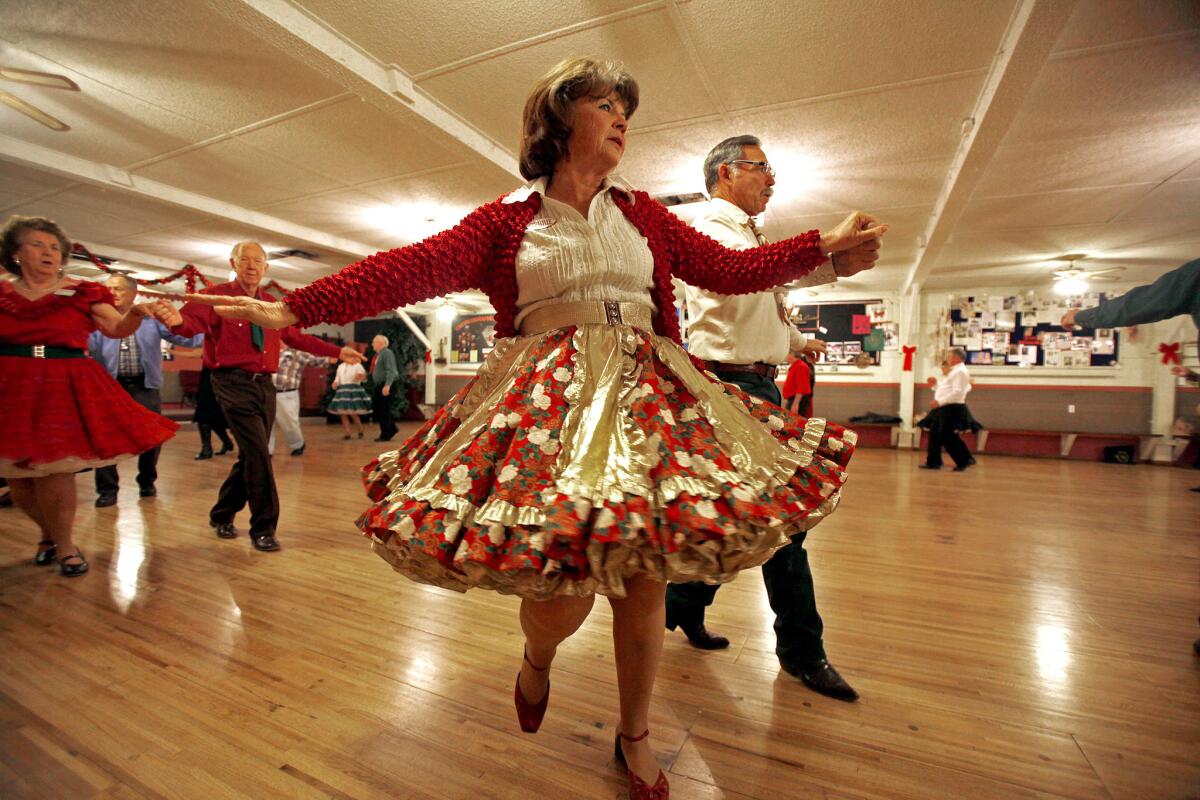
Terrie Livreri, 64, of Pinon Hills, dances with Mike Livreri, 62, at Cowtown Square Dance Center. Terrie says they have been coming here for 13 years. More photos
The fact that she and so many others in their club have gotten married has become something of a joke.
"We're Cowtown Singles," she said, "but we're almost all married."

On dance nights, it doesn't take long for the parking lot to fill with cars. During the week, dancers gather for classes and potlucks and parties. One dancer even had his memorial service at Cowtown. Between each eulogy, the mourners cleared the floor for a tip.
It's a place to celebrate the most joyous moments of their lives and to find support in the worst.
Eva Arthurs turned to square dancing to get her through losing husbands — and to find new ones. Her second husband got her into square dancing decades ago. Then she met her third, recuperated from a "heartbreaking" divorce, and landed yet another.
"He walked across the floor," said Arthurs, a 72-year-old retired department store saleswoman with a snowy perm and impish smile, "and I said, 'He's my next victim!' "
His death five years ago, she said, left her a "vegetable." Her square-dancing friends, she said, "brought me out of that."
It was the same for Betty Lawyer. After her daughter died, Cowtown was where she sought refuge.
"It was such a happy place to come when there was so much sadness at home."

Each dance night begins with the pledge of allegiance and the last tip ends with the dancers holding hands and bowing. "Thank you!" they bellow to the caller. No matter where in the world you go, the calls are made in English. And, at most places, there's no alcohol allowed.
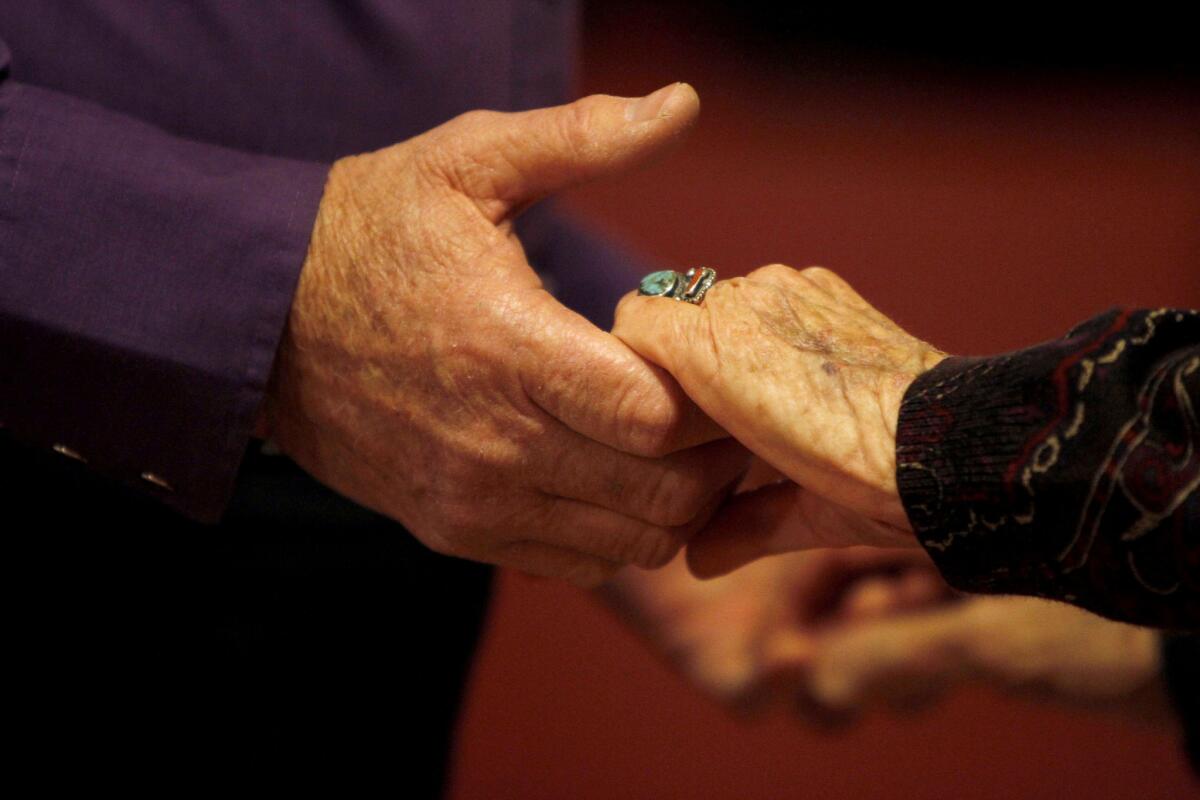
Ed Worley, 77, of Ruining Springs, and Julie Michael, 84, of Tamecula, dance the last round of the evening together at Cowtown. More photos
Talk of going to a bar makes many of the square dancers shudder. They think of blaring music, booze and awkward small talk. Here, it seems much more easygoing. "It's not a pressure-cooker situation for most people," Jim Selby said.
On this night, as the others danced, Betsy Keeley was among the women sitting at the back of the hall. Some stayed off the floor because square dancing had become too rough on their joints, or their balance wasn't what it used to be. Others were waiting for their turn on one of the men's dance cards.
"Most of the women are good about sharing their partners — at least for one dance," said Keeley, 71, who started square dancing after her husband died eight years ago. "I've never had to sit out too much."
The caller began playing an Eric Clapton song that's a popular closer — a string of calls punctuated by "And I say yes, you look wonderful tonight."
Keeley was still in her seat at the back of the hall, her short brown hair coiffed and her makeup just so. It looked as though she'd be sitting this one out. But just then, Dan Lawyer came by and whisked her off to the floor, her skirt springing with each step.
Follow Rick Rojas(@RaR) on Twitter
Follow @latgreatreads on Twitter
More great reads
Lovers in the twilight time celebrate each moment
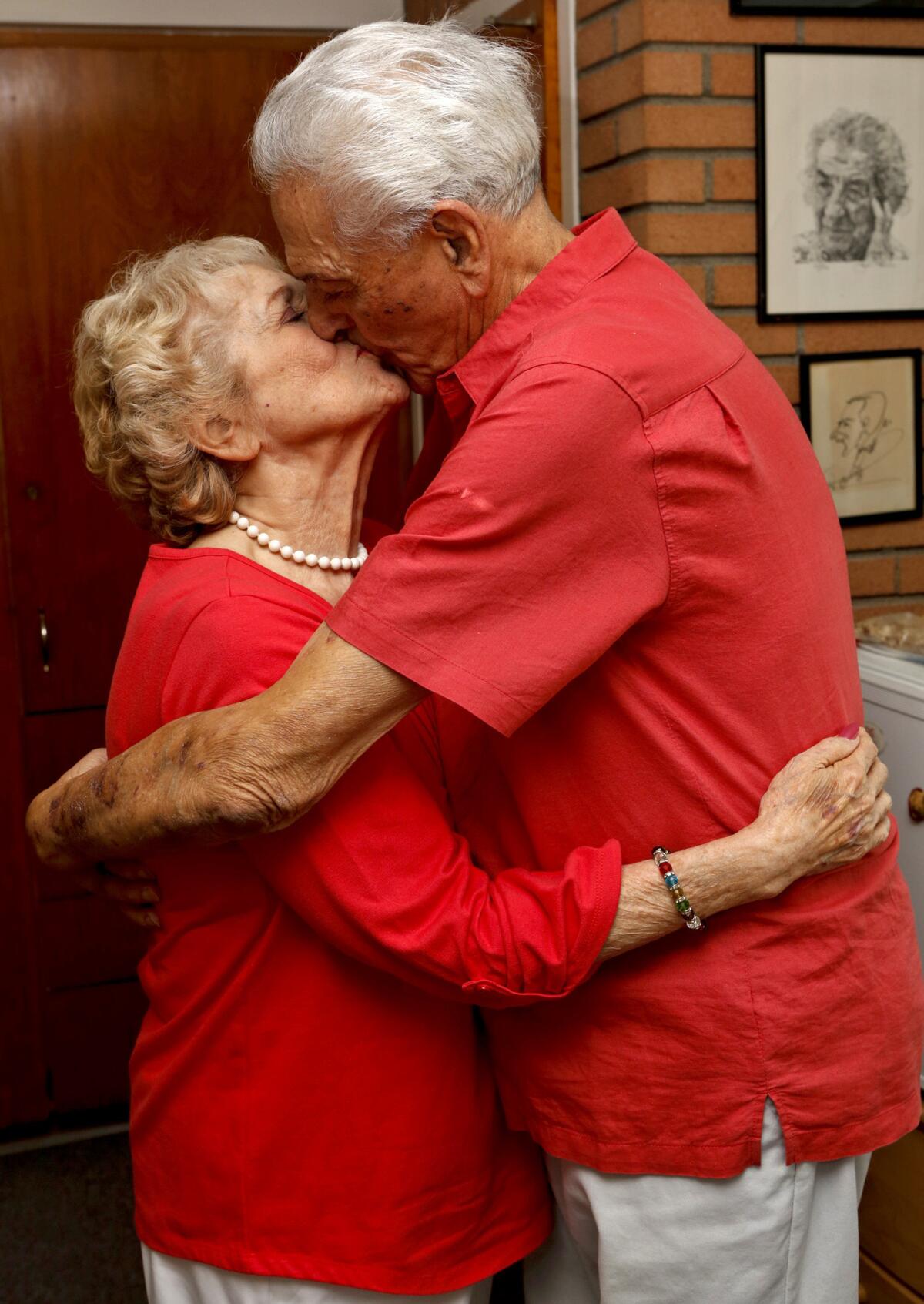
From falling in like, it grew to love. And at our age that's simply spectacular.”
In a grim city, a drill team marches to an uplifting beat
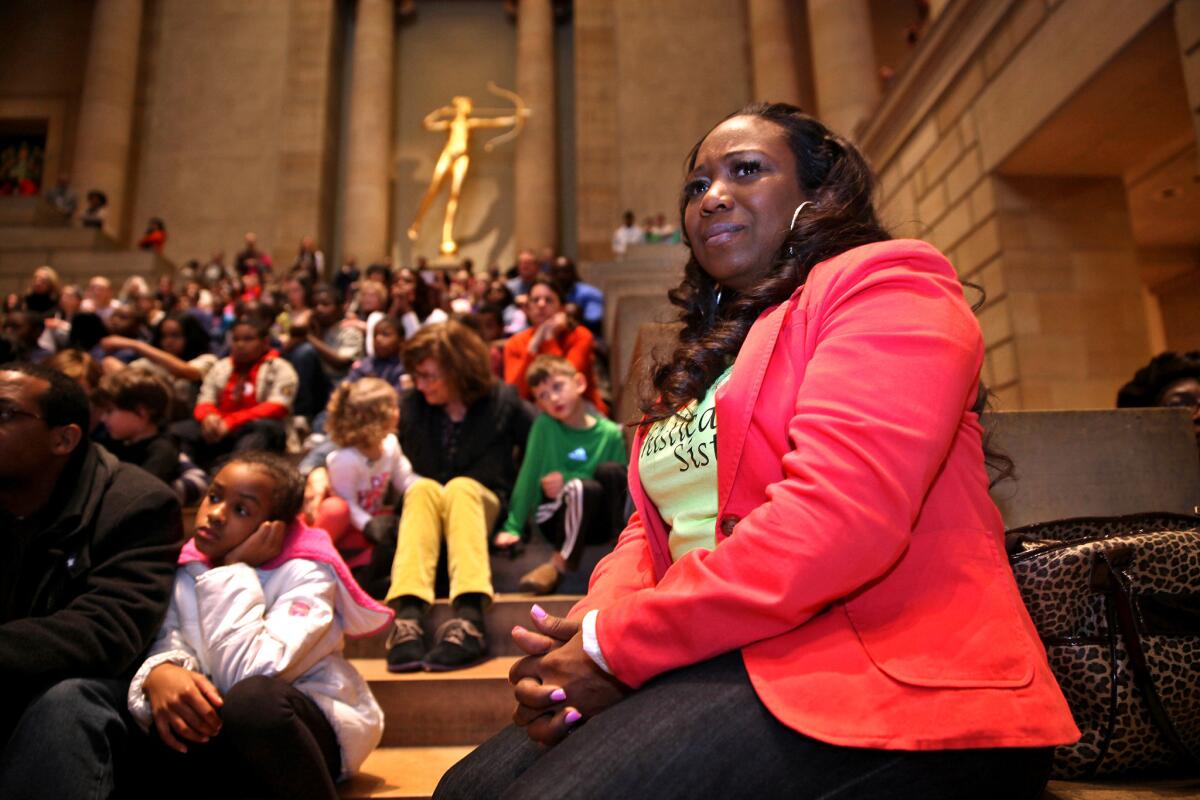
This whole thing has to do with saving lives, not just marching in front of the cameras.”
Sign up for Essential California
The most important California stories and recommendations in your inbox every morning.
You may occasionally receive promotional content from the Los Angeles Times.
